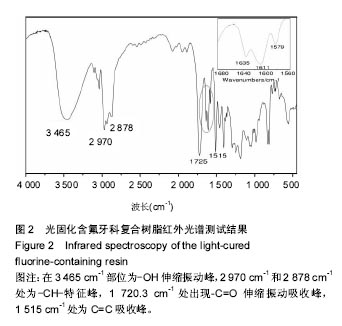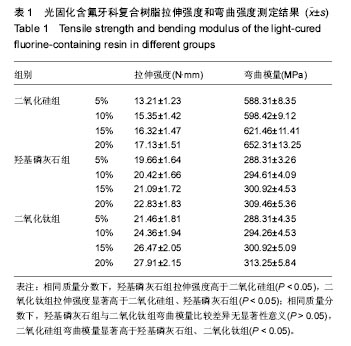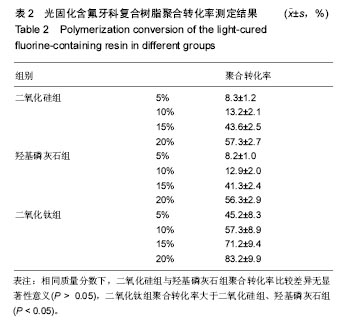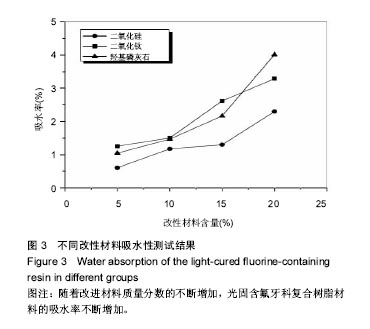| [1]刘红光,杨倩,刘桂锋,等.国内外 3D 打印快速成型技术的专利情报分析[J].情报杂志,2013,32(6):40-46. [2]李怀学,巩水利,孙帆,等.金属零件激光增材制造技术的发展及应用[J].航空制造技术,2012,55(20):26-31. [3]李东方,陈继民,袁艳萍,等.光固化快速成形技术的进展及应用[J].北京工业大学学报,2015,41(12):1769-1774. [4]侯桂香,谢建强,高俊刚,等.环氧丙烯酸酯/EP自由基—阳离子混杂光固化涂膜的性能[J].中国胶黏剂,2015,24(8):429-432. [5]Chiu SH,Wicaksono ST,Chen KT.Morphology and properties of a photopolymer/clay nanocomposite prepared by a rapid prototyping system.Sci Eng Compos Mater.2014;21(2): 205-210. [6]杨明山,赵祎宁,赵明,等.三维打印成型用混杂型光固化树脂的制备[J].现代塑料加工应用,2015,27(6):5-8. [7]Kumar S,Hofmann M,Steinmann B,et al.Reinforcement of stereolithographic resins for rapid prototyping with cellulose nanocrystals.ACS Appl Mater Interfaces. 2012;4(10): 5399-5407.[8]Chiacchiarelli LM,Puri I,Puglia D,et al.The relationship between nanosilica dispersion degree and the tensile properties of polyurethane nanocomposites.Colloid Polym Sci.2013;291(12):2745-2753. [9]Wajid AS,Tanvir Ahmed HS,Das S, et al.High-performance pristine graphene/epoxy composites with enhanced mechanical and electrical properties.Macromol Mater Eng. 2013;298(3):339-347. [10]王学宝,李晋庆,罗运军.石墨烯/环氧树脂复合材料的制备及力学性能[J].高分子材料科学与工程,2013,29(7):161-165.[11]陈建剑,俞科静,钱坤,等.石墨烯改性环氧树脂/碳纤维复合材料的拉伸性能的研究[J].化工新型材料,2012,40(9):63-65. [12]Li YF,Zhu JH,Wei SY,et al.Poly(propylen)/graphene nanoplatelet nanocomposites:Melt rheological behavior and thermal, electrical, and electronic properties.Macromol Chem Phys.2011;212(18):1951-1959. [13]龚娜娟,吕永根,杨常玲,等.氧化石墨烯对丙烯腈聚合物及溶液流变性能的影响[J].高科技纤维与应用,2013,38(2):20-24. [14]胡乔涵,郭盟,陈子栋,等.光敏性聚氨酯低聚物改性纳米二氧化硅及在光固化聚氨酯体系的应用[J].高分子材料科学与工程,2014, 30(9):128-133. [15]王虎,杜秀才,赵凯锋,等.炭黑对聚氨酯丙烯酸酯和环氧丙烯酸酯性能的影响研究[J].涂料工业,2016,46(2):22-47. [16]王强,尹娇娇,杨华哲.口腔修复材料氧化锆生物陶瓷的制备方法及应用进展[J].中国组织工程研究,2016,20(21):3178-3184. [17]Roriz VM,Rosa AL,Peitl O,et al.Efficacy of a bioactive glass–ceramic (Biosilicate) in the maintenance of alveolar ridges and in osseointegration of titanium implants.Clin Oral Implants Res.2010;21(2):148-155. [18]Turp V,Tuncelli B,Sen D,et al.Evaluation of hardness and fracture toughness, coupled with microstructural analysis, of zirconia ceramics stored in environments with different pH values.Dent Mater J.2012;31(6):891-902. [19]郭蓓,袁琨,陈伟.人工听骨链重建材料生物相容性、特性及修复喉软骨缺损的效果[J].中国组织工程研究,2016,20(25): 3713-3719. [20]孙安科,李万同,孟庆延,等.带蒂肌筋膜瓣充填与包裹构建喉支架形态组织工程软骨[J].中华耳鼻咽喉头颈外科杂志,2011,46(12): 1019-1023. [21]刘清宇,王富友,杨柳.关节软骨组织工程支架的研究进展[J].中国修复重建外科杂志,2012,26(10):1247-1250. [22]孙安科,胡平,李万同,等.组织工程PHBHH多孔材料喉支架的制备与细胞相容性研究[J].听力学及言语疾病杂志, 2011,19(6): 558-561.[23]Bus MP,Bramer JA,Schaap GR,et al.Hemicortical resection and inlay allograft reconstruction for primary bone tumors: a retrospective evaluation in the Netherlands and review of the literature.J Bone Joint Surg Am.2015;97(9):738-750.[24]Haraguchi K,Takada T.Characteristic sliding frictional behavior on the surface of nanocomposite hydrogels consisting of organic-inorganic network structure. Macromol Chem Phys. 2015;206(15):1530-1540.[25]孔杰,李国强,叶菁芸,等.纳米银/壳聚糖复合水凝胶的原位制备、表征及抗菌性能研究[J].功能材料, 2012,12(43):1662-1664.[26]姚超,卜令学,王科,等.应用细胞片层技术构建组织工程骨修复犬下颌骨缺损的实验研究[J]. 华西口腔医学杂志,2012,30(3): 229-233.[27]王尖,孙斌,李玉宝,等.聚氨酯基抗菌根管充填材料的制备与性能研究[J].功能材料,2014,14(45):2001-2004.[28]Zulkifli FH,Jahir Hussain FS,Abdull Rasad MS,et al.Improved cellular response of chemically crosslinked collagen incorporated hydroxyethyl cellulose/poly (vinyl)alcohol nanofibers scaffold.J Biomater Appl.2015;29(7):1014-1027.[29]29 Alagöz D,Yildirim D,Güvenmez HK,et al.Covalent Immobilization and Characterization of a Novel Pullulanase from Fontibacillus sp. Strain DSHK 107 onto Florisil® and Nano-silica for Pullulan Hydrolysis.Appl Biochem Biotechnol. 2016;179(7):1262-1274. [30]Wang L,Yu Q.Methane adsorption on porous nano-silica in the presence of water: An experimental and ab initio study.J Colloid Interface Sci.2016;467:60-69. [31]Lu CF,Yuan XY,Li LZ,et al.Combined exposure to nano-silica and lead induced potentiation of oxidative stress and DNA damage in human lung epithelial cells.Ecotoxicol Environ Saf.2015;122:537-544. [32]Mukharjee BB,Barai SV.Development of construction materials using nano-silica and aggregates recycled from construction and demolition waste.Waste Manag Res. 2015; 33(6):515-523. |
.jpg)





.jpg)
.jpg)
.jpg)
.jpg)